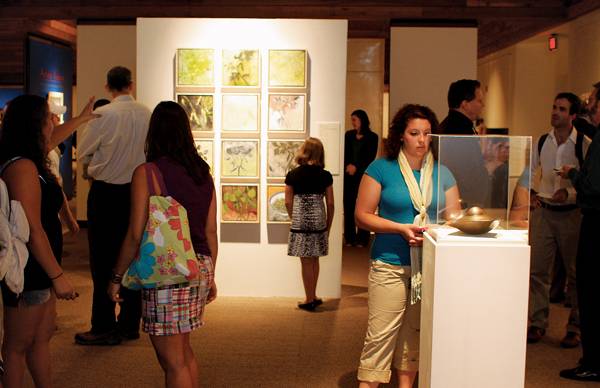Art, science merge for a unique display

Visitors tour the ReLationShips: From Our Roots exhibition on Thursday, Sept. 10, 2009, at the Brunnier Art Meseum in the Scheman Building. The exhibition features four artists, and will go until December 31, 2009. Photo: Shing Kai Chan/Iowa State Daily
September 10, 2009
The Brunnier Art Museum, 290 Scheman Building, opened the first of a six-part exhibition called ReLationShips: From our Roots. The first exhibition featured “an interesting dialogue between art and science,” said Luis Rico-Gutierrez, dean of the College of Design.
“Having that dialogue is the responsibility of the artist, and I think this is a perfect example of that,” he said.
The event “coincides with the celebration of the 30th anniversary of the College of Design,” said Ingrid Lilligren, professor of art and design and guest curator for the exhibit.
All four artists featured in the exhibit are alumni and colleagues of the College of Design’s studio art program, and collaborated with members of Iowa State’s scientific community.
The artists from the studio art program are Joe Muench, Barbara Eckhardt Walton, Carol Faber, and Cindy Gould.
Lilligren said another rotation of the exhibit will open in the spring with three or four different artists, all alumni and colleagues of the College of Design.
Faber, one of the artists currently featured in the exhibit, collaborated with Wolfgang Weber, teaching lab associate in biomedical sciences in the College of Veterinary Medicine, for her display.
Together, they produced digital prints that represent the relationship between animals and art.
Elizabeth Hoffman, executive vice president and provost, praised the exhibit, saying “art and veterinary medicine really stretches our imagination of how art and animals can work together, but animals are so ubiquitous subjects of art as well.”
One element of the exhibit that seemed popular among those in attendance was “Roger Died,” by Gould, associate professor in art and design.
Gould’s late husband, Roger, died after suffering from amyotrophic lateral sclerosis. The mixed-media piece, which is housed in a section of the museum in which patrons can actually walk through it, “explores death as part of life from the perspective of a widow,” according to a wall plaque.
The piece is interactive, allowing patrons to share feelings on scraps of white cloth, which are later hung across the room on a clothesline. Among the ones currently displayed are: “Love is forever!,” “You are my sunshine and my shadow,” “Guess how much I love you” and “I carry you in my heart.”
Hoffman said the integration of the arts and sciences is an important part of our future.
“As we look at the great problems of the twenty-first century,” she said, “yes, they are science problems; yes, they are engineering problems; yes, they are architectural problems; but they are design problems as well.”
















